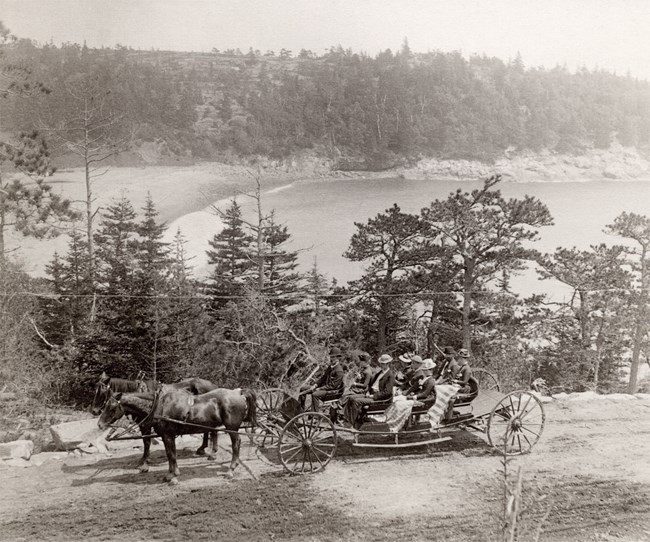
From Paths to RoadsAlthough present-day visitors traditionally drive to the top of Cadillac Mountain before dawn to witness the first sunlight striking the American continent, the roads of Mount Desert Island were not always so accommodating. Since time immemorial, Wabanaki people traveled throughout the island using a sophisticated network of footpaths. When European colonists arrived in 1761, they too used these paths, widening many to make room for horses and buckboard wagons. The trail to the top of Cadillac Mountain, for instance, was widened and made a toll road during the 1850s. Early European settlers to Mount Desert Island quickly began constructing their own roads in order to enhance economic and social interaction. As early as 1777, residents had connected the island communities of Bar, Bass, and Southwest harbors with crude roads that were often impassable during inclement weather. Early Pressure on Roads and the 'Auto Wars'Over time, a network of roads across Mount Desert Island and the Schoodic Penninsula began to modernize. Increases in tourism and the rise of the automobile during the final decades of the nineteenth century, led some residents promoted road construction as a means of drawing visitors to the island. In 1888, for example, locals built a road to the shore of Eagle Lake in an effort to promote the island as a vacation destination. Other islanders were less enthused and a time period known locally as the 'auto wars' ensued. In 1903, voters on Mount Desert Island voted to ban automobiles on the island and in 1909 the Maine state legislature banned automobiles from all Maine island roads. Over the years, many locals found creative ways to challenge the ban, even to the point of being arrested for 'coasting' their automobile down a hill instead of 'driving' it.Summer resident John D. Rockefeller, Jr., whose family fortune resulted from the Standard Oil Company, ironically saw the increase in the number of cars as a threat to his idyllic island getaway. In reaction to this symbol of urban industrial society, he constructed carriage roads for horse and foot traffic only. By 1941 he had built more than forty miles of such roads throughout the east side of the island. The first roads were built on his Seal Harbor estate; later roads were constructed on park lands, or land which Mr. Rockefeller acquired and later turned over to the park. Park founder, George B. Dorr, worked out a compromise that let some autos come to the island via some roads. Later, around 1911, Southwest Harbor was the first community on the island to vote to allow cars, with Bar Harbor following in 1913. 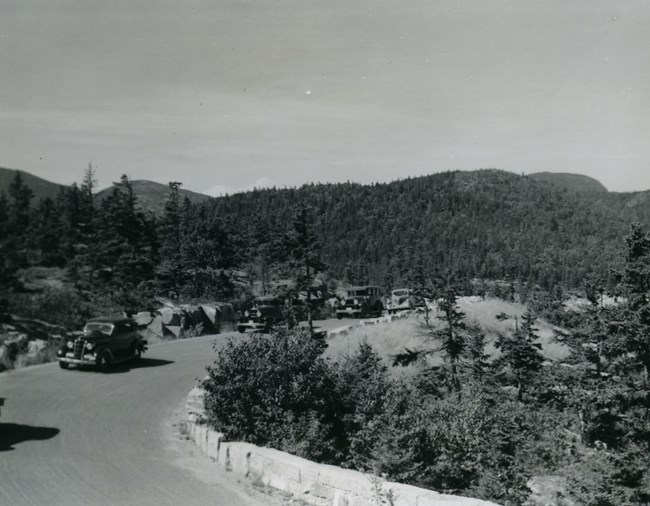
Courtesy National Park Service/Acadia National Park Plans For Motor RoadsAcadia’s motor road system was constructed over a 36 year period. The planning and design were not without challenges resulting from a difficult topography, private and public land ownership, economic verses conservation interests, and the financial constraints brought on by the Great Depression and World War II. From Vision to RealityGeorge Dorr, a central figure in the park’s establishment and its first superintendent, had a vision in 1922 for connecting the Eagle Lake and Jordan Pond areas and allowing access to reach Cadillac Mountain. John D. Rockefeller brought these ideas to fruition by personally funding most of the motor road projects, in addition to expanding access to the park on his famous carriage roads. Using his connections to leadership in the National Park Service and wealth to acquire and donate lands, Rockefeller played a critical role in setting a standard for roadways and landscapes in national parks. 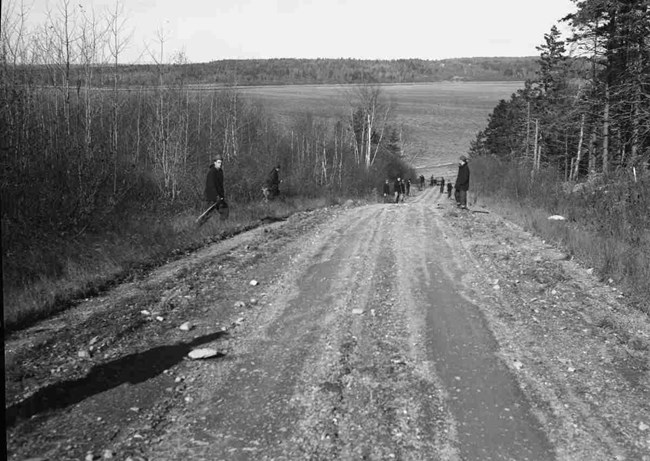
Courtesy National Park Service/Acadia National Park A Thoughtful DesignThe motor roads were praised for their scenic quality and careful consideration of moving with the land, but local opposition still came from those who feared negative impacts to the area. Rockefeller's original hope for the Park Loop Road was ultimately altered by this community opposition, but the final segment was completed by the Bureau of Public Roads (BPR) in 1958. 
Historic American Engineering Record, National Park Service, Harlen D. Groe, 1995 Construction and FeaturesThe motor roads at Acadia were constructed with some distinct features:
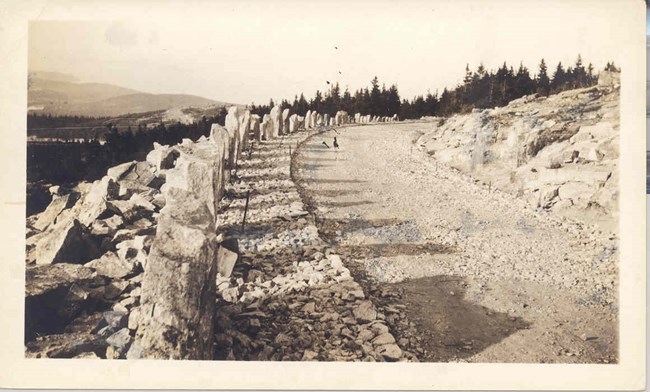
Courtesy National Park Service/Acadia National Park The roads intentionally move with the land, allowing for visitors to view and experience the landscape without sacrificing the topography. The motor road system was integrated with the carriage road system and hiking trails, creating a network for visitors to explore Acadia by car, foot, carriage, and later bicycle. Despite a long construction period, a consistent use of the Rustic Design is still visible today – where roads blend with natural features as much as possible. Much of the vegetation along the roads was destroyed in the Fire of 1947 but have since rebounded. These plants along the road shoulders and in wetlands, meadows, and forests continue to help blend the roads with the park’s landscape. 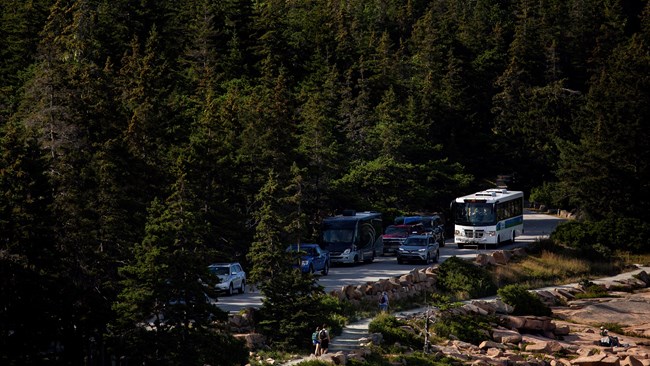
Photo by Ashley L. Conti, Friends of Acadia, NPS Maintenance and Future of Motor RoadsAfter Rockefeller’s death in 1960, the combination of lessened interest, limited staff, and shrinking budgets for maintenance meant motor roads and carriage roads feel into disrepair. With the assistance of special projects, volunteers, and donations by Friends of Acadia, the historic motor roads were rehabilitated and continue to be maintained – offering the same park driving tour experience intended by the visionaries, planners, engineers, and designers. In recent years, transportation issues at the park have become more complex as Acadia's visitation increases. Traffic congestion from private vehicles, concessions buses, commercial tour coaches, public transportation shuttle buses, and bicycles creates public safety issues, impacts to the historic motor road system, and impacts to the park's natural and cultural resources. . |
Last updated: November 1, 2023
